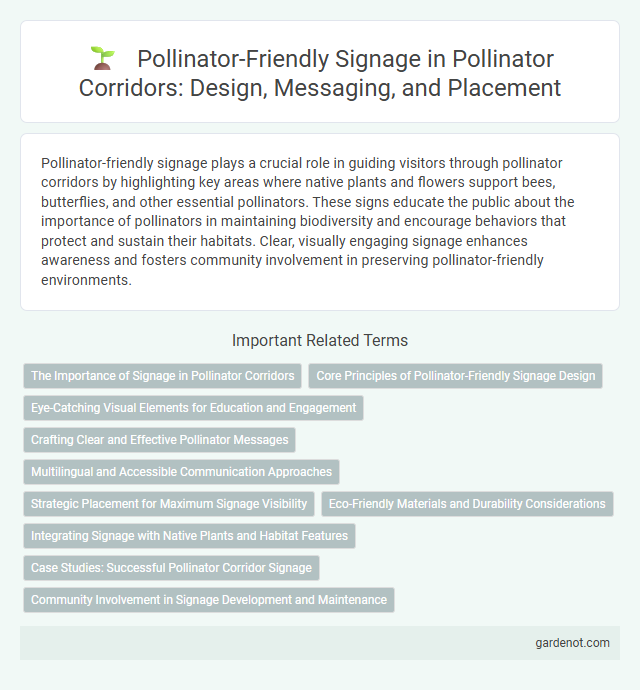Pollinator-friendly signage plays a crucial role in guiding visitors through pollinator corridors by highlighting key areas where native plants and flowers support bees, butterflies, and other essential pollinators. These signs educate the public about the importance of pollinators in maintaining biodiversity and encourage behaviors that protect and sustain their habitats. Clear, visually engaging signage enhances awareness and fosters community involvement in preserving pollinator-friendly environments.
The Importance of Signage in Pollinator Corridors
Pollinator-friendly signage enhances awareness and educates the public about the critical role of pollinator corridors in supporting biodiversity and ecosystem health. Effective signage uses clear visuals and concise information to highlight native plant species, pollinator behavior, and conservation efforts, fostering community engagement and stewardship. Strategic placement of signs along corridors ensures maximum visibility, encouraging responsible practices that protect pollinators and promote habitat connectivity.
Core Principles of Pollinator-Friendly Signage Design
Pollinator-friendly signage should prioritize clear visual hierarchy, using bold icons and contrasting colors to enhance readability from a distance and ensure quick recognition of pollinator species and their habitats. Incorporating accurate, scientifically vetted information about local pollinators and flowering plants supports educational value and encourages community engagement in conservation efforts. Durable, weather-resistant materials and strategic placement along pollinator corridors optimize the longevity and effectiveness of the signage in promoting habitat connectivity and biodiversity.
Eye-Catching Visual Elements for Education and Engagement
Pollinator-friendly signage uses vibrant colors, bold graphics, and clear icons to attract attention and convey important information about native pollinators and their habitats. Incorporating QR codes and interactive elements encourages deeper engagement, fostering community awareness and support for pollinator corridor initiatives. Effective visual design enhances learning experiences and promotes conservation behaviors among passersby.
Crafting Clear and Effective Pollinator Messages
Crafting clear and effective pollinator-friendly signage involves using simple language paired with impactful visuals that highlight the importance of pollinators like bees, butterflies, and hummingbirds. Signage should emphasize actionable steps, such as planting native flowers, avoiding pesticides, and creating safe habitats, to engage and educate the public. Using bold fonts, vibrant colors, and concise messaging increases visibility and encourages community participation in pollinator corridor initiatives.
Multilingual and Accessible Communication Approaches
Pollinator-friendly signage incorporates multilingual and accessible communication approaches to ensure inclusivity and effectiveness in promoting pollinator conservation. Clear visuals, simple language, and translations in multiple local languages enhance comprehension for diverse communities, including non-native speakers and those with disabilities. Braille, pictograms, and QR codes linking to audio descriptions support accessibility, fostering widespread engagement in pollinator corridor initiatives.
Strategic Placement for Maximum Signage Visibility
Strategic placement of pollinator-friendly signage near garden entrances, pathways, and pollinator habitats enhances visibility and educational impact. Positioning signs at eye level and in high-traffic areas ensures maximum engagement and awareness among visitors. Incorporating vibrant colors and clear icons further attracts attention and reinforces pollinator conservation messages effectively.
Eco-Friendly Materials and Durability Considerations
Pollinator-friendly signage crafted from eco-friendly materials such as recycled wood, bamboo, or biodegradable composites ensures minimal environmental impact while promoting sustainability. Durable coatings like UV-resistant varnishes and weatherproof paints protect signs from fading and degradation, extending their lifespan in outdoor settings. Strategic material selection balances ecological responsibility with resilience, guaranteeing that informational displays effectively support pollinator corridors over time.
Integrating Signage with Native Plants and Habitat Features
Pollinator-friendly signage enhances environmental awareness by clearly identifying native plants and habitat features that support pollinator species such as bees, butterflies, and hummingbirds. Integrating these signs with local flora provides educational value while promoting conservation efforts within pollinator corridors. Effective signage uses durable, weather-resistant materials and includes QR codes to link visitors to detailed information on native pollinators and their habitat requirements.
Case Studies: Successful Pollinator Corridor Signage
Case studies of pollinator-friendly signage reveal effective strategies for enhancing public awareness and engagement in pollinator corridors, such as using clear, informative graphics and location-specific messaging. Successful examples include urban parks in Portland and community gardens in Toronto, where signs incorporate QR codes linking to educational resources and interactive maps. These signs have increased visitor knowledge about native pollinators like bumblebees and monarch butterflies, fostering conservation support through targeted visual communication.
Community Involvement in Signage Development and Maintenance
Community involvement in pollinator-friendly signage development fosters local ownership and awareness, enhancing the corridor's impact on pollinator conservation. Engaging residents and stakeholders in designing, placing, and maintaining signs ensures messages resonate culturally and environmentally, increasing educational effectiveness. This collaborative approach supports ongoing habitat protection and pollinator-friendly behaviors within the community.
Pollinator-friendly signage Infographic

 gardenot.com
gardenot.com